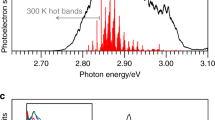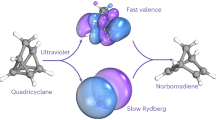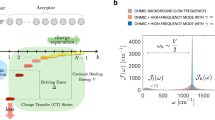Abstract
Quinones feature prominently as electron acceptors in nature. Their electron-transfer reactions are often highly exergonic, for which Marcus theory predicts reduced electron-transfer rates because of a free-energy barrier that occurs in the inverted region. However, the electron-transfer kinetics that involve quinones can appear barrierless. Here, we consider the intrinsic properties of the para-benzoquinone radical anion, which serves as the prototypical electron-transfer reaction product involving a quinone-based acceptor. Using time-resolved photoelectron spectroscopy and ab initio calculations, we show that excitation at 400 and 480 nm yields excited states that are unbound with respect to electron loss. These excited states are shown to decay on a sub-40 fs timescale through a series of conical intersections with lower-lying excited states, ultimately to form the ground anionic state and avoid autodetachment. From an isolated electron-acceptor perspective, this ultrafast stabilization mechanism accounts for the ability of para-benzoquinone to capture and retain electrons.
This is a preview of subscription content, access via your institution
Access options
Subscribe to this journal
Receive 12 print issues and online access
$259.00 per year
only $21.58 per issue
Buy this article
- Purchase on Springer Link
- Instant access to full article PDF
Prices may be subject to local taxes which are calculated during checkout



Similar content being viewed by others
References
El-Najjar, N. et al. The chemical and biological activities of quinones: overview and implications in analytical detection. Photochem. Rev. 10, 353–370 (2011).
Nohl, H., Jordan, W. & Youngman, R. J. Quinones in biology: functions in electron transfer and oxygen activation. Adv. Free Radical. Bio. 2, 211–279 (1986).
Iverson, T. M., Luna-Chavez, C. S., Cecchini, G. & Rees, D. C. Structure of the Escherichia coli fumarate reductase respiratory complex. Science 284, 1961–1966 (1999).
Marcus, R. A. & Sutin, N. Electron transfers in chemistry and biology. Biochim. Biophys. Acta 811, 265–322 (1985).
Rehm, D. & Weller, A. Kinetics and mechanics of electron transfer during fluorescence quenching in acetonitrile. Ber. Bunsenges. Phys. Chem. 73, 834–839 (1969).
Rehm, D. & Weller, A. Kinetics of fluorescence quenching by electron and H-atom transfer. Isr. J. Chem. 8, 259–271 (1970).
Calcaterra, L. T., Closs, G. L. & Miller, J. R. Fast intramolecular electron transfer in radical ions over long distances across rigid saturated hydrocarbon spacers. J. Am. Chem. Soc. 105, 670–672 (1983).
Closs, G. L., Calcaterra, L. T., Green, N. J., Penfield, K. W. & Miller, J. R. Distance, stereoelectronic effects, and the Marcus inverted region in intramolecular electron transfer in organic radical anions. J. Phys. Chem. 90, 3673–3683 (1986).
Indelli, M. T., Ballardini, R. & Scandola, F. Experimental investigation of highly exergonic outer-sphere electron-transfer reactions. J. Phys. Chem. 88, 2547–2551 (1984).
Miller, J. R., Calcaterra, L. T. & Closs, G. L. Intramolecular long-distance electron transfer in radical anions. The effects of free energy and solvent on the reaction rates. J. Am. Chem. Soc. 106, 3047–3049 (1984).
Closs, G. L. & Miller, J. R. Intramolecular long-distance electron-transfer in organic molecules. Science 240, 440–447 (1988).
Schiedt, J. & Weinkauf, R. Resonant photodetachment via shape and Feshbach resonances: p-benzoquinone anions as a model system. J. Chem. Phys. 110, 304–314 (1999).
Barbara, P. F., Meyer, T. J. & Ratner, M. A. Contemporary issues in electron transfer research. J. Phys. Chem. 100, 13148–13168 (1996).
Marcus, R. A. & Siders, P. Theory of highly exothermic electron transfer reactions. J. Phys. Chem. 86, 622–630 (1982).
Mataga, N., Chosrowjan, H. & Taniguchi, S. Ultrafast charge transfer in excited electronic states and investigations into fundamental problems of exciplex chemistry: our early studies and recent developments. J. Photochem. Photobiol. C 6, 37–79 (2005).
Morandeira, A., Engeli, L. & Vauthey, E. Ultrafast charge recombination of photogenerated ion pairs to an electronic excited state. J. Phys. Chem. A 106, 4833–4837 (2002).
Petersson, J., Eklund, M., Davidsson, J. & Hammarström, L. Ultrafast electron transfer dynamics of a Zn(II)porphyrin–viologen complex revisited: S2 vs S1 reactions and survival of excess excitation energy. J. Phys. Chem. B 114, 14329–14338 (2010).
Weber, J., Malsch, K. & Hohlneicher, G. Excited electronic states of p-benzoquinone. Chem. Phys. 264, 275–318 (2001).
El Ghazaly, M. O. A., Svendsen, A., Bluhme, H., Nielsen, S. B. Ø . & Andersen, L. H. Electron scattering on p-benzoquinone anions. Chem. Phys. Lett. 405, 278–281 (2005).
Siegert, S., Vogeler, F. & Weinkauf, R. Direct access to the dipole-forbidden n π* T1 state of p-benzoquinone by photodetachment photoelectron spectroscopy. Z. Phys. Chem. 225, 507–516 (2011).
Mariam, Y. H. & Chantranupong, L. Electron affinities of p-benzoquinone, p-benzoquinone imine and p-benzoquinone diimine, and spin densities of their p-benzosemiq. J. Comput. Aided Mol. Des. 11, 345–356 (1997).
Mohandas, P. & Umapathy, S. Density-functional studies on the structure and vibrational spectra of transient intermediates of p-benzoquinone. J. Phys. Chem. A 101, 4449–4459 (1997).
Pou-Amérigo, R., Serrano-Andrés, L., Merchán, M., Ortí, E. & Forsberg, N. A theoretical determination of the low-lying electronic states of the p-benzosemiquinone radical anion. J. Am. Chem. Soc. 122, 6067–6077 (2000).
Honda, Y., Hada, M., Ehara, M. & Nakatsuji, H. Excited and ionized states of p-benzoquinone and its anion radical: SAC-CI theoretical study. J. Phys. Chem. A 106, 3838–3849 (2002).
Fu, Q., Yang, J. & Wang, X-B. On the electronic structures and electron affinities of the m-benzoquinone (BQ) diradical and the o-, p-BQ molecules: a synergetic photoelectron spectroscopic and theoretical study. J. Phys. Chem. A 115, 3201–3207 (2011).
Christophorou, L. G., Carter, J. G. & Christodoulides, A. A. Long-lived parent negative ions in p-benzoquinone formed by electron capture in the field of the ground and excited states. Chem. Phys. Lett. 3, 237–240 (1969).
Collins, P. M., Christophorou, L. G., Chaney, E. L. & Carter, J. G. Energy dependence of the electron attachment cross section and the transient negative ion lifetime for p-benzoquinone and 1,4-naphthoquinone. Chem. Phys. Lett. 4, 646–650 (1970).
Cooper, C. D., Naff, W. T. & Compton, R. N. Negative ion properties of p-benzoquinone: electron affinity and compound states. J. Chem. Phys. 63, 2752–2757 (1975).
Suzuki, T. Femtosecond time-resolved photoelectron imaging. Annu. Rev. Phys. Chem. 57, 555–592 (2006).
Verlet, J. R. R. Femtosecond spectroscopy of cluster anions: insights into condensed-phase phenomena from the gas-phase. Chem. Soc. Rev. 37, 505–517 (2008).
Pegg, D. J. Structure and dynamics of negative ions. Rep. Prog. Phys. 67, 857–905 (2004).
Wigner, E. P. On the behavior of cross sections near thresholds. Phys. Rev. 73, 1002–1009 (1948).
Baguenard, B., Pinaré, J. C., Bordas, C. & Broyer, M. Photoelectron imaging spectroscopy of small tungsten clusters: direct observation of thermionic emission. Phys. Rev. A 63, 023204 (2001).
Hansen, K., Hoffmann, K. & Campbell, E. E. B. Thermal electron emission from the hot electronic subsystem of vibrationally cold C60 . J. Chem. Phys. 119, 2513–2522 (2003).
Horke, D. A. & Verlet, J. R. R. Photoelectron spectroscopy of the model GFP chromophore anion. Phys. Chem. Chem. Phys. 14, 8511–8515 (2012).
Bernardi, F., Olivucci, M. & Robb, M. A. Potential energy surface crossings in organic photochemistry. Chem. Soc. Rev. 25, 321–328 (1996).
Domcke, W., Yarkony, D. R. & Köppel, H. Conical Intersections: Electronic Structure, Dynamics and Spectroscopy (World Scientific, 2004).
Klessinger, M. & Michl, J. Excited States and Photochemistry of Organic Molecules (VCH, 1995).
Yarkony, D. R. Conical intersections: the new conventional wisdom. J. Phys. Chem. A 105, 6277–6293 (2001).
Simons, J. in Resonances in Electron-Molecule Scattering, van der Waals Complexes, and Reactive Chemical Dynamics (ed. Truhlar, D. G.) (ACS Symposium Series 263, American Chemical Society, 1984).
Verlet, J. R. R., Bragg, A. E., Kammrath, A., Cheshnovsky, O. & Neumark, D. M. Time-resolved relaxation dynamics of Hgn− (11 ≤ n ≤ 16, n = 18) clusters following intraband excitation at 1.5 eV. J. Chem. Phys. 121, 10015–10025 (2004).
Ulstrup, J. & Jortner, J. The effect of intramolecular quantum modes on free energy relationships for electron transfer reactions. J. Chem. Phys. 63, 4358–4368 (1975).
Horke, D. A., Roberts, G. M. & Verlet, J. R. R. Excited states in electron-transfer reaction products: ultrafast relaxation dynamics of an isolated acceptor radical anion. J. Phys. Chem. A 115, 8369–8374 (2011).
Horke, D. A. & Verlet, J. R. R. Time-resolved photoelectron imaging of the chloranil radical anion: ultrafast relaxation of electronically excited electron acceptor states. Phys. Chem. Chem. Phys. 13, 19546–19552 (2011).
Lecointre, J., Roberts, G. M., Horke, D. A. & Verlet, J. R. R. Ultrafast relaxation dynamics observed through time-resolved photoelectron angular distributions. J. Phys. Chem. A 114, 11216–11224 (2010).
Roberts, G. M., Lecointre, J., Horke, D. A. & Verlet, J. R. R. Spectroscopy and dynamics of the 7,7,8,8-tetracyanoquinodimethane radical anion. Phys. Chem. Chem. Phys. 12, 6226–6232 (2010).
Horke, D. A., Roberts, G. M., Lecointre, J. & Verlet, J. R. R. Velocity-map imaging at low extraction fields. Rev. Sci. Instrum. 83, 063101 (2012).
Eppink, A. T. J. B. & Parker, D. H. Velocity map imaging of ions and electrons using electrostatic lenses: application in photoelectron and photofragment ion imaging of molecular oxygen. Rev. Sci. Instrum. 68, 3477–3484 (1997).
Roberts, G. M., Nixon, J. L., Lecointre, J., Wrede, E. & Verlet, J. R. R. Toward real-time charged-particle image reconstruction using polar onion-peeling. Rev. Sci. Instrum. 80, 053104 (2009).
Ghigo, G., Roos, B. O. & Malmqvist, P-Å. A modified definition of the zeroth-order Hamiltonian in multiconfigurational perturbation theory (CASPT2). Chem. Phys. Lett. 396, 142–149 (2004).
Frisch, M. J. et al. Gaussian 09 A.02 (Gaussian, Inc., Wallingford, Connecticut, 2009).
Karlström, G. et al. MOLCAS: a program package for computational chemistry. Comp. Mater. Sci. 28, 222–239 (2003).
Acknowledgements
This work was funded by the Engineering and Physical Sciences Research Council (EP/D073472/1), the Spanish Ministerio de Ciencia e Innovación (MICINN) (CTQ2011-26573 and UNGI08-4E-003 from the European Fund for Regional Development) and the Catalan Agència de Gestió d'Ajuts Universitaris i de Recerca (SGR0528). Q.L. acknowledges a Juan de la Cierva fellowship of the MICINN. J.R.R.V. thanks the European Research Council for a Starting Grant.
Author information
Authors and Affiliations
Contributions
D.A.H. and Q.L. contributed equally to this work. D.A.H. and J.R.R.V. conceived the project and performed all the experiments. Q.L. and L.B. designed and performed all the calculations. Q.L. and D.A.H. analysed the computational and experimental results. All authors discussed the results and contributed to the manuscript.
Corresponding authors
Ethics declarations
Competing interests
The authors declare no competing financial interests.
Supplementary information
Supplementary information
Supplementary information (PDF 742 kb)
Rights and permissions
About this article
Cite this article
Horke, D., Li, Q., Blancafort, L. et al. Ultrafast above-threshold dynamics of the radical anion of a prototypical quinone electron-acceptor. Nature Chem 5, 711–717 (2013). https://doi.org/10.1038/nchem.1705
Received:
Accepted:
Published:
Issue Date:
DOI: https://doi.org/10.1038/nchem.1705



